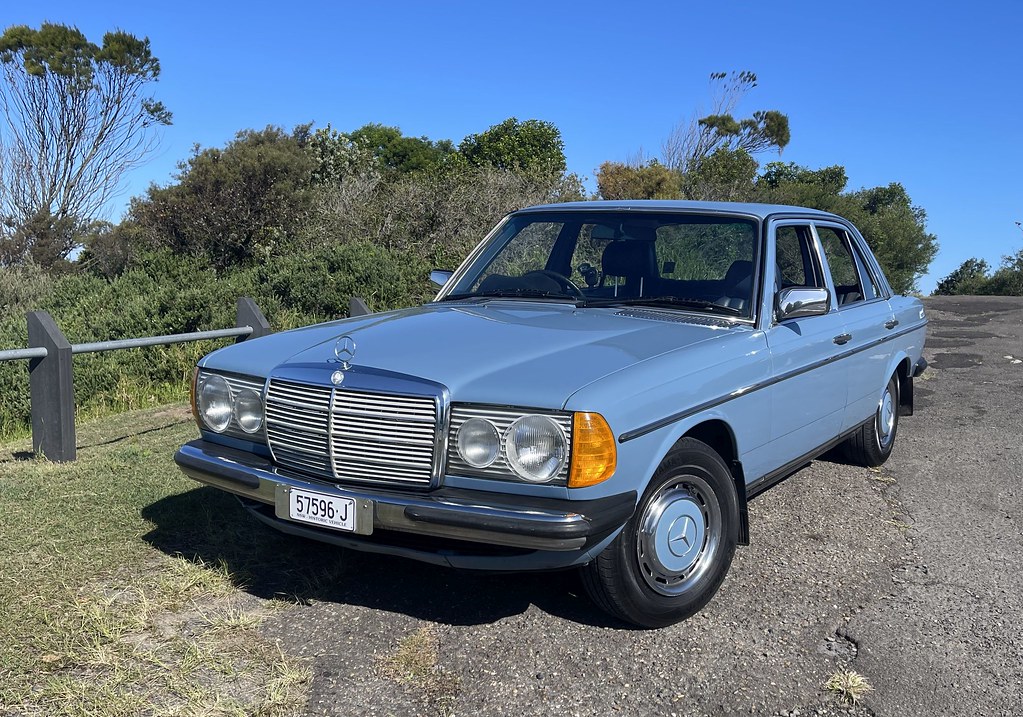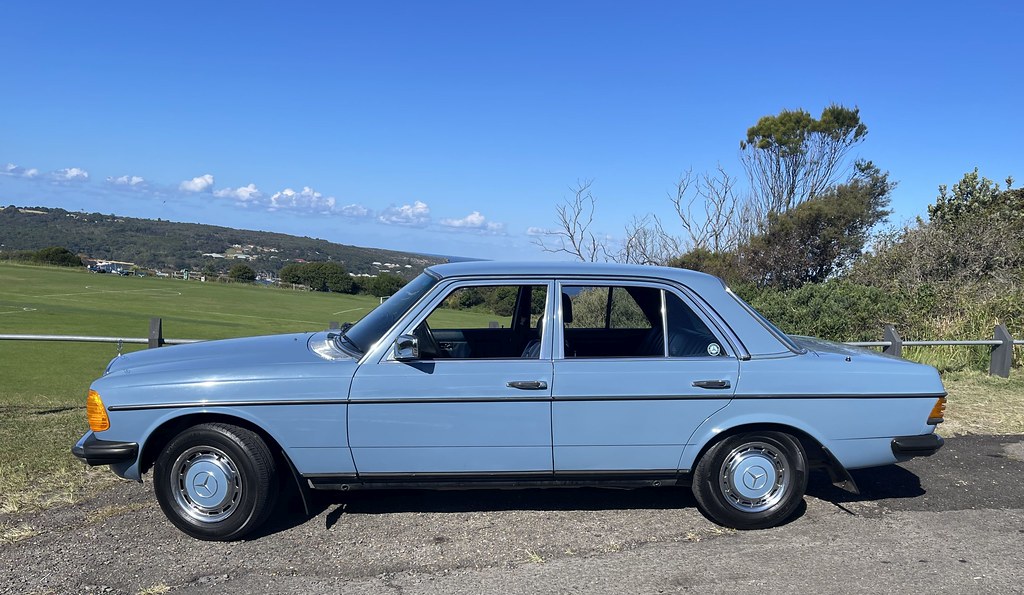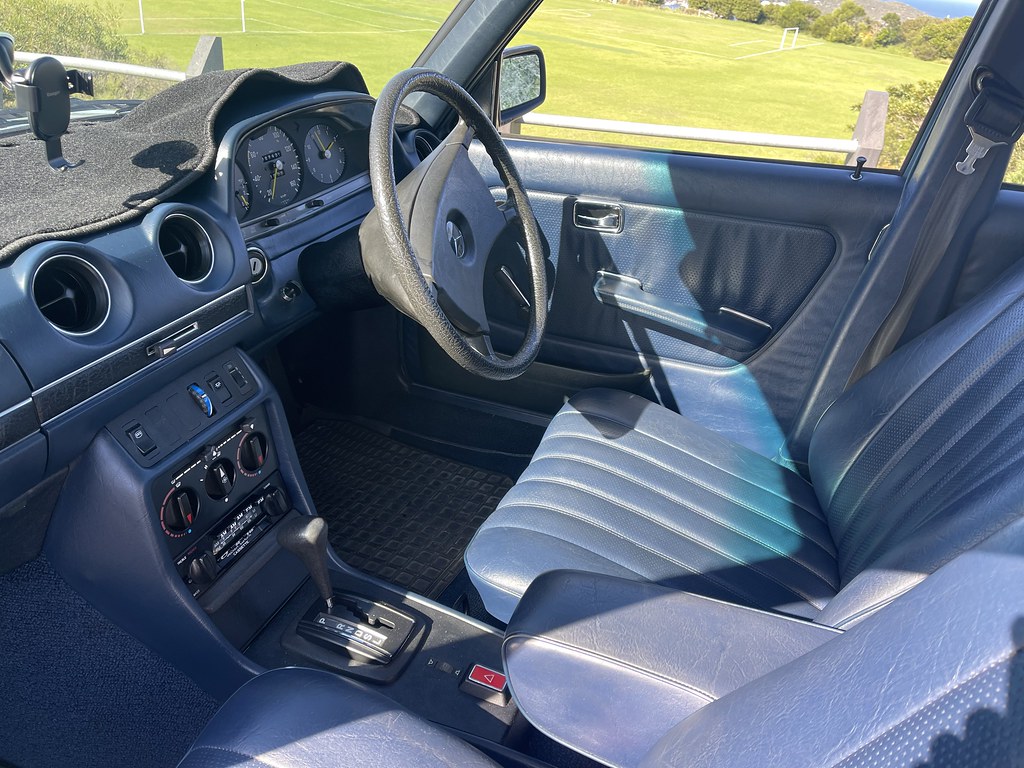About the 1981 Mercedes 240D
The W123 Series is one of the most successful and beloved models in Mercedes-Benz history. It was the midrange model in the lineup from late 1976 to 1985. Today this place is occupied my the E-Class. The W123 series has a reputation of impeccable engineering and incredible longevity. If there was any model that epitomises that, it was the 240D. Of the almost 2.7M W123s made, almost 450,000 of them were 240Ds. It is fitting that the 240D is type 123.123.
In Europe the 240D was the taxi of choice. More powerful and usable than the 200D or 220D, and with almost no fuel penalty. In other parts of the world it was an entry level Mercedes-Benz with rugged simplicity.
In Australia it had more of a niche role in the lineup. It was never a huge seller and appealed mostly to value oriented country buyers who valued its impeccable engineering as well as low running cost over big mileages. While it was a very expensive car, it would last far longer than anything else you could buy, so in the long term it was quite good value.
The 240D was launched in Australia with the rest of the W123 range in November 1976. However, it was discontinued by June of 1978. This was the original version with 64hp, and was offered with an automatic transmission. In June of 1980 the 240D was reintroduced with the option of a manual transmission as well as the automatic. This was now the updated version with 71hp. The 240D would continue until the end of 1982 when it was discontinued again. My guess is that the advent of the 230E killed demand. Diesel buyers still had the 300D and the 230E was no more expensive and so much better than the old 230 carby.
Today there are few left. There is not a single one historically registered by the Mercedes-Benz club of NSW (at 4/24). Never a big seller to begin with, the 240D was far less popular on the used car market. Once the cars dropped down in price, buyers wanted the 280E, 230E and 300D. The 240D suffered due to the reputation of it being dangerously slow with an automatic transmission. While the 240D is not a fast car by any means, this reputation was unfair. Lack of maintenance on the vacuum system would cause the transmissions to shift into top gear far too early, and the cars would bog down and be unable to accelerate. Maintained properly, the automatic is not nearly as slow as most think.
There were two other factors in the demise of the 240D in Australia. The first was the aftermarket turbo kits that were popular in the 80s. Even some dealers apparently offered them. Stuttgart would have been horrified. While the OM615/616 and 617 engines are rugged and long lived, they did not respond well to turbocharging. The 617A offered in the USA was a highly modified engine from its natural aspirated cousin. The naturally aspirated engines did not last long with this kit. The kits were quite popular, and at one point they were regularly advertised for sale. Most of the engines blew up. I’ve seen one in the last 10 years, on a 300D.
The second was low values in Australia and high values in the Middle East and Africa. During the late 90s and 2000s, there were multiple scrappers sending container load after container load of scrapped W123s out of Australia and buying any car they could get their hands on for less than $1,000. This really thinned the numbers. Unfortunately we didn’t realize what we had until it was too late.
About this car
This 1981 240D rolled off the production line in November of 1980. It would not go through Australian compliance until August of 1981, and it was finally sold to its first owner 18/12/81 by Lanes Motors in Melbourne.
The car is a very standard Australian specification 240D. It is finished in China Blue, which I think is one of the best of the standard colours. It has blue MB-Tex interior, air conditioning, power steering and a Becker Europa Cassette. there are no other options, which is how I think a 240D should be – the appeal of the model is rugged simplicity.
The car would be a Melbourne car until my purchase in 2024, and up until then it was still fully registered on its original plate of BHB-084. It seemed to have spent a lot of its life in the Doncaster area, with at least one owner in Gippsland. I am told by a Melbourne local that a lot of fruit growing families lived in the Doncaster area back then, which would have been a natural buyer for such a car.
I bought the car from a deceased estate, and while I have the original logbook, I am very keen to learn more about the history of this car. The car is in remarkably good condition, and my assumption is that it was the pride and joy of an elderly person who was not able to drive it much in recent years. It was still kept fully registered.
Option codes
| Option Code | Meaning |
|---|---|
| 426 | 420: Power Steering 422: Automatic Transmission, Floor Shift |
| 466 | Central locking |
| 503 | Outside rear view mirror, on the left |
| 524 | Paintcoat preservation |
| 533 | Interference Suppression without radio |
| 570 | Folding armrest, front |
| 580 | Behr A/C |
| 599 | Heat insulating glass for side and rear |
| 613 | Lamp unit for LH traffic |
| 625 | Version for Australia |
| 656 | Michelin Tyres |
| 668 | 662: 10l of fuel 666: Packing VE II |
| 674 | High-capacity battery, tropical version |
| 801 | Model Year 1981 |
Why did I buy it?
This isn’t an obvious car for me to buy. On this site I have criticized models like the 420SEL and ADR 280 models for being too slow. Why would I buy an automatic 240D?
Firstly, I’ve always wanted to own a diesel Mercedes-Benz of this era. They have such a loyal fan base, and the W123 diesel is so iconic in the history of the marque. I think this is a car that every classic Mercedes-Benz enthusiast should own at least one.
Secondly, the rugged simplicity of the car appeals. One of the things I dislike about modern cars is the technology for technology’s sake. The 240D is the antithesis of this.
I’ve outlined in more detail what the car is like to drive in this article.
Related posts
- April 2024 - Enter the slow lane - My first W123 diesel
- April 2024 - First jobs on the 240D
- April 2024 - What is a 1981 240D Automatic like to drive?
- May 2024 - W123 under bonnet insulation
- May 2024 - 240D motor mounts, engine shock and thermostat




